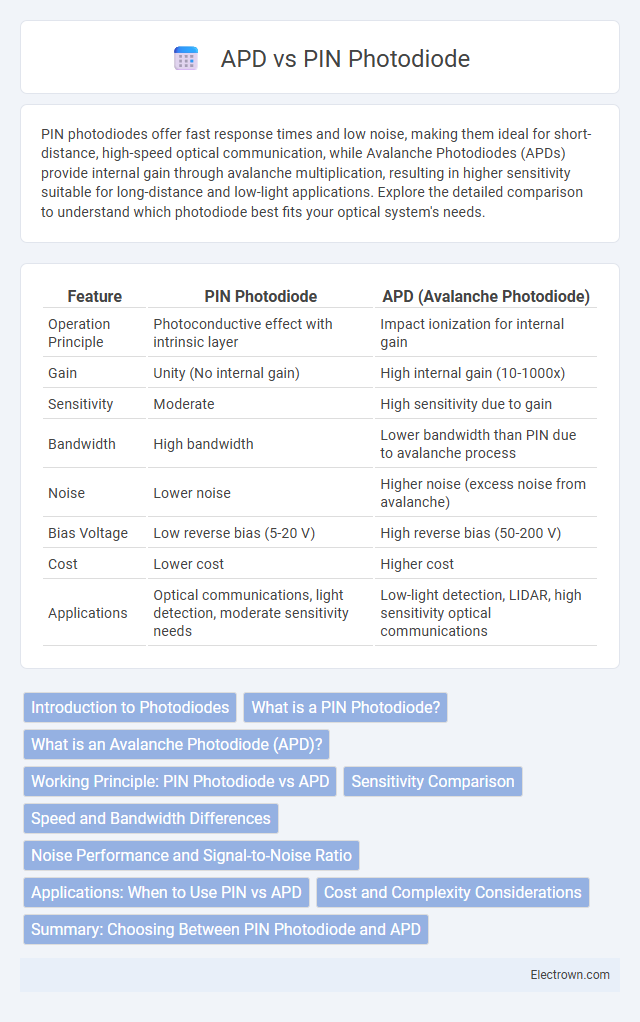PIN photodiodes offer fast response times and low noise, making them ideal for short-distance, high-speed optical communication, while Avalanche Photodiodes (APDs) provide internal gain through avalanche multiplication, resulting in higher sensitivity suitable for long-distance and low-light applications. Explore the detailed comparison to understand which photodiode best fits your optical system's needs.
Table of Comparison
| Feature | PIN Photodiode | APD (Avalanche Photodiode) |
|---|---|---|
| Operation Principle | Photoconductive effect with intrinsic layer | Impact ionization for internal gain |
| Gain | Unity (No internal gain) | High internal gain (10-1000x) |
| Sensitivity | Moderate | High sensitivity due to gain |
| Bandwidth | High bandwidth | Lower bandwidth than PIN due to avalanche process |
| Noise | Lower noise | Higher noise (excess noise from avalanche) |
| Bias Voltage | Low reverse bias (5-20 V) | High reverse bias (50-200 V) |
| Cost | Lower cost | Higher cost |
| Applications | Optical communications, light detection, moderate sensitivity needs | Low-light detection, LIDAR, high sensitivity optical communications |
Introduction to Photodiodes
Photodiodes, such as PIN photodiodes and avalanche photodiodes (APDs), play a critical role in converting light into electrical signals for optical communication and sensing applications. PIN photodiodes offer fast response times and high linearity, making them ideal for low-noise, moderate-sensitivity tasks, while APDs provide internal gain through avalanche multiplication, significantly enhancing sensitivity for weak light detection. Understanding the differences between these devices helps you select the optimal photodiode to match your required sensitivity, speed, and noise performance in photonic systems.
What is a PIN Photodiode?
A PIN photodiode is a semiconductor device with an intrinsic layer sandwiched between p-type and n-type regions, designed to convert light into electrical current with high speed and linearity. Unlike avalanche photodiodes (APDs), PIN photodiodes operate without internal gain, providing lower noise and simpler biasing, making them ideal for applications requiring fast response and moderate sensitivity. Your choice of a PIN photodiode suits scenarios where stable, low-noise detection of optical signals is essential without the complexity of avalanche multiplication.
What is an Avalanche Photodiode (APD)?
An Avalanche Photodiode (APD) is a highly sensitive semiconductor device designed to detect low levels of light by amplifying the photocurrent through an internal avalanche multiplication process. Unlike a standard PIN photodiode, which directly converts photons into electrical current, the APD uses a high reverse bias voltage to trigger impact ionization, significantly increasing the signal gain. If your application requires enhanced sensitivity and faster response, APDs offer superior performance in low-light conditions compared to traditional photodiodes.
Working Principle: PIN Photodiode vs APD
PIN photodiodes operate by generating electron-hole pairs when photons are absorbed in the intrinsic layer, producing a photocurrent proportional to light intensity without internal gain. Avalanche photodiodes (APDs) amplify the photocurrent through impact ionization, where high reverse bias voltage causes carriers to multiply, significantly increasing sensitivity. Your choice between PIN and APD depends on the required sensitivity and noise performance for your optical detection application.
Sensitivity Comparison
An APD (Avalanche Photodiode) offers significantly higher sensitivity than a PIN photodiode due to its internal gain mechanism, which amplifies the photocurrent before noise is added, making it ideal for detecting weak optical signals. PIN photodiodes provide fast response times and low noise but lack the internal gain, resulting in lower sensitivity compared to APDs. Your choice should consider that APDs perform better in low-light conditions, while PIN photodiodes are preferred for high-speed applications where moderate sensitivity suffices.
Speed and Bandwidth Differences
PIN photodiodes offer faster response times and wider bandwidths due to their simple structure with a thin intrinsic layer that allows quick charge carrier collection. Avalanche photodiodes (APDs) exhibit slower response speeds because the avalanche multiplication process introduces additional delay and higher capacitance, limiting their bandwidth. For high-speed, broad-bandwidth applications, PIN photodiodes are preferred, whereas APDs are chosen when sensitivity is prioritized over speed.
Noise Performance and Signal-to-Noise Ratio
PIN photodiodes exhibit lower noise levels due to their simpler structure and lack of internal gain, resulting in a more stable and predictable noise performance. Avalanche Photodiodes (APDs) provide higher sensitivity through internal gain but introduce excess noise from the avalanche multiplication process, which can degrade the signal-to-noise ratio (SNR) in low-light conditions. Your choice depends on the balance between desired sensitivity and acceptable noise levels, with PIN photodiodes favored for applications requiring low noise and APDs suitable for detecting weak optical signals where higher gain is necessary.
Applications: When to Use PIN vs APD
PIN photodiodes are ideal for applications requiring low noise and fast response times, such as fiber optic communication and light detection where sensitivity is moderate. Avalanche photodiodes (APDs) excel in high-sensitivity applications like LIDAR, medical imaging, and photon counting due to their internal gain and higher signal amplification. Your choice between PIN and APD should depend on the need for sensitivity versus speed and noise tolerance in your specific application.
Cost and Complexity Considerations
PIN photodiodes typically offer lower cost and simpler design compared to Avalanche Photodiodes (APDs), making them ideal for budget-conscious applications with moderate sensitivity requirements. APDs require higher bias voltages and complex amplification circuits due to their internal gain mechanism, increasing overall system complexity and expense. Your choice depends on balancing performance needs against these cost and complexity factors.
Summary: Choosing Between PIN Photodiode and APD
Choosing between a PIN photodiode and an avalanche photodiode (APD) depends on your application's sensitivity and speed requirements. PIN photodiodes offer lower noise and faster response, ideal for high-speed optical communication but with moderate sensitivity. APDs provide higher sensitivity through internal gain, making them suitable for low-light detection despite increased noise and complexity.
PIN photodiode vs APD Infographic

 electrown.com
electrown.com